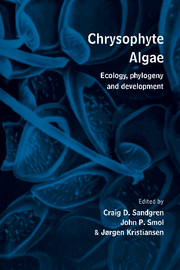Book contents
- Frontmatter
- Contents
- Preface
- List of contributors
- 1 History of chrysophyte research: origin and development of concepts and ideas
- Part I Phylogeny, systematics and evolution
- Part II Development, physiology and nutrition
- Part III Ecology, paleoecology and reproduction
- 9 Chrysophyte blooms in the plankton and neuston of marine and freshwater systems
- 10 Biogeography of chrysophytes in Finnish lakes
- 11 The distribution of chrysophytes along environmental gradients: their use as biological indicators
- 12 The influence of zooplankton herbivory on the biogeography of chrysophyte algae
- 13 Application of chrysophytes to problems in paleoecology
- Part IV Contributed original papers
- Index of scientific names
- Subject index
13 - Application of chrysophytes to problems in paleoecology
Published online by Cambridge University Press: 05 March 2012
- Frontmatter
- Contents
- Preface
- List of contributors
- 1 History of chrysophyte research: origin and development of concepts and ideas
- Part I Phylogeny, systematics and evolution
- Part II Development, physiology and nutrition
- Part III Ecology, paleoecology and reproduction
- 9 Chrysophyte blooms in the plankton and neuston of marine and freshwater systems
- 10 Biogeography of chrysophytes in Finnish lakes
- 11 The distribution of chrysophytes along environmental gradients: their use as biological indicators
- 12 The influence of zooplankton herbivory on the biogeography of chrysophyte algae
- 13 Application of chrysophytes to problems in paleoecology
- Part IV Contributed original papers
- Index of scientific names
- Subject index
Summary
Introduction
Chrysophytes have long been recognized to be powerful indicators of environmental conditions (e.g. Siver, this volume); however, only recently have they been used extensively in paleoecological studies. In many ways, the increased use of chrysophyte microfossils has closely tracked the heightened interest and application of paleoecological approaches to the study of environmental change (see Davis 1989; Smol 1990a, b, 1992; Battarbee 1991; Smol & Glew 1992; and Charles et al. 1994 for recent reviews and commentaries). Historical perspectives, such as those that can be gleaned from lake sediments using paleoecological approaches, have now been melded into a wide array of studies that cover both theoretical and applied aspects of limnology (Smol 1990a). With these proxy data, long-term environmental conditions and variability can be assessed, hypotheses can be generated and tested, and models can be verified.
This chapter highlights some of the recent advances in the use of chrysophytes as paleolimnological markers, and stresses examples that I believe are most relevant to phycologists. Because of the increased volume of literature, it is no longer possible to provide a thorough synthesis in an article of this size. The reader is referred to reviews by Adam & Mahood (1981), Cronberg (1986a, b Kristiansen (1986) and Smol (1987, 1988a), who summarize much of the historical literature on chrysophyte microfossils and provide a point of departure for this chapter. Smol (1990c) compiled a bibliography of most work on chrysophyte-based paleolimnology published in the 1980s.
- Type
- Chapter
- Information
- Chrysophyte AlgaeEcology, Phylogeny and Development, pp. 303 - 330Publisher: Cambridge University PressPrint publication year: 1995
- 45
- Cited by



